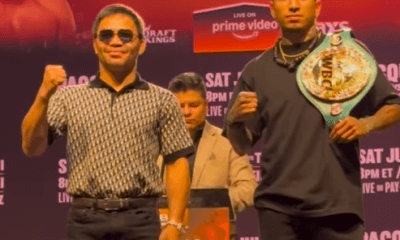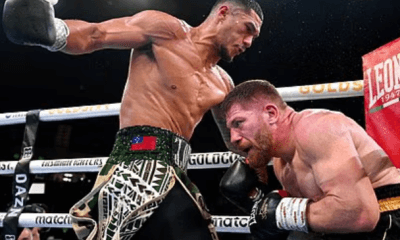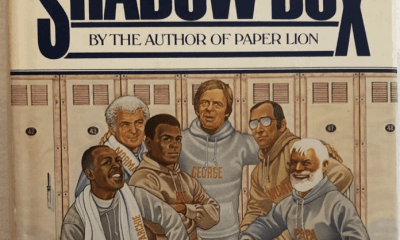Featured Articles
A Love Letter to Boxing
 Tyson-Spinks hooked the writer on the sweet and savage science…and the sport has never let go of his heart and soul since then.
Tyson-Spinks hooked the writer on the sweet and savage science…and the sport has never let go of his heart and soul since then.
September is one of the better months in recent memory for our fine sport. We’ve already witnessed the coming-out party of future middleweight star Gennady Golovkin (RELEASE THE GOLVKIN!), we saw a barnburner between Daniel Geale and Felix Sturm, and we’ve got potential super fights Ward-Dawson and Chavez-Martinez yet to come. Augmented by a solid Showtime card featuring Canelo Alvarez as well as both a Klitschko title fight and documentary on HBO – well, what better time to reflect on why I love the sport?
It’s easy to get down on the sport sometimes. We all know how many things boxing seems to get wrong. There’s no reason to list them here.
For all its ailments, though, boxing does a lot of things right. The very nature of the sport draws men and women to it like moths to a flame and for damn good reason. There’s simply nothing like it.
A fight is like nothing else.
If you’ve ever been in a fist fight, you know that every second can feel like an eternity. It’s everything at once. Parts of it seem so long. Other parts seem so short, and before you know it, it’s all over. It’s like it never happened, but it did: like a dream.
So it is for those of us who try to capture the sport in written word, too. There is simply not enough time to capture the ebb and flow of a round (much less the entire fight) between the time the final bell rings to when an article goes to press. At the same time, a good fight seems to last forever.
It seems a riddle, this boxing of ours, but perhaps it’s no more strange than the very idea of the sport itself – two men (or women) enter a ring on guts and guile alone, intent on bashing each other’s faces in, and leave with a closer bond than even the best of friends could forge together.
So very strange it is, this sweet science, that all any of us can do is gather round to watch.
It is a science. Don’t let anyone tell you different. Find the meanest, toughest guy you can find on the street and have him head to a boxing gym. He’ll learn quickly the importance of method and approach.
It’s also an art. I dare say there is more art in today’s pugilism than what’s left in our popular music. Have a listen to your radio. You’ll see. Even our culture’s authors have left us rifling through bins of classic literature searching for something appreciable.
Ah, but boxing…
Behold Floyd Mayweather, the most gifted fighter in our sport. Like his outside the ring antics or despise them, you cannot help but be rendered speechless by his fistic brilliance.
Hail Manny Pacquiao, the brilliant embodiment of weaponized aggression. You may prefer a more defensive approach than his, but you can’t help but shudder at the piston-like precision of his ferocity.
Observe Andre Ward. His technical acumen is only superseded by the workings of his inner spirit aimed carefully towards doing what must be done to maintain his status as victor.
The list goes on and on.
Boxers are infinitely appreciable. So much so, in fact, that we give them nicknames to try and capture the essence of their craft. We call them things like “Sugar,” “Hitman” and “The Real Deal.”
Boxing is bigger than any other sport in the world, but it’s also somehow the least appreciated in today’s world. Any barfly will tell you the world’s greatest sportsman in the last 100 years was a boxer named Muhammad Ali. The same know-it-all tells you other combat sports have somehow passed it by.
He is wrong because his definition of our sport lacks authenticity. Boxing isn’t just a combat sport. It is more than that. Boxing is savage poetry. It is music infused with fire and spit and blood. It’s teeth and tenacity bolstered by artful repose.
Boxing is all that and more.
Yes, they kick and punch in mixed martial arts, but boxing is more than that. It is a gentleman’s agreement to tactically engage in the rhythm of souls brought together solely by a mutual intention to dole out punishment on each other’s bodies for the simple reason that each man exists.
Or maybe it’s just a fist fight for money. I can never tell.
But boxing is for everyone. Its fierce aggression and brutality can be appreciated by anyone, from the artist to the street vendor to the businessman. It’s for the barfly who thinks he knows about the sport because he hit his brother once and the busboy who’s never dared to punch anyone but can list every heavyweight champion who has ever lived. It’s for wives and sisters who see art in the decadence of bloodlust, and it’s for husbands and brothers who live vicariously through the Hectors and Achilles of their day.
Have you ever met a fighter in his old age that couldn’t help but stammer out words of longing for the bygone days that made him that way? Do you know boxing writers who travel by hook or crook to get to gigs that never pay more than their trip fare?
Boxing isn’t for the faint of heart. It is for the full of heart.
It is for men like Evander Holyfield and Arturo Gatti. It’s for those who see victory in defeat and hope when the dawn seems darkest. It is for women like Claressa Shields and Marlen Esparza who have so few shoulders of giants to stand on, but do so anyway. It’s for men who carve livings out of it any way they can and for the rest of us who try but can’t seem to do it. It’s for the people who save up money to travel hours away from their homes to see a fight from the most expensive seats they can afford, and it’s for the working men and women who scrounge together just enough cash with their friends and relatives to buy this month’s big pay per view.
Boxing is for anyone and everyone who wants it. It is ours.
I remember the first fight I ever saw. Don’t we all? I was just a boy then. Mike Tyson was the scariest man on the planet. I was mesmerized by him the way we used to be with ghosts, goblins and the boogeyman, but Mike Tyson was real.
Some would say he came to the ring that night against Michael Spinks like a crazed animal, but there was more to it than that. Spinks would not fear senseless violence. Spinks would have a plan against such a Neanderthal tactic as that. He’d have strategy against directionless savagery, but scientifically trained brutality was all together a different kind of beast. Tyson was honed fury, forged under the watchful eye of Cus D’Amato, a professor of the sport who filled Mike’s brain with images of frightful pioneers like Jack Dempsey and Sonny Liston.
Tyson stormed through the helpless Spinks in ninety-one seconds that night, and I was hooked forever.
It is perhaps too ambitious to transmit all that boxing means to me in something as silly as words, but maybe, like boxing, the reward isn’t always in the result, but in the undertaking.
Someone once told me that burning embers don’t remember what they were before the flame. So it is with the souls engulfed in the fires of boxing. Whether it was because of my age or my vocation at the time, I do not remember who I was before I began to love boxing. Frankly, I would not want to.
-

 Featured Articles3 weeks ago
Featured Articles3 weeks agoAvila Perspective, Chap. 330: Matchroom in New York plus the Latest on Canelo-Crawford
-

 Featured Articles2 weeks ago
Featured Articles2 weeks agoVito Mielnicki Jr Whitewashes Kamil Gardzielik Before the Home Folks in Newark
-

 Featured Articles4 weeks ago
Featured Articles4 weeks agoAvila Perspective, Chap 329: Pacquiao is Back, Fabio in England and More
-

 Featured Articles3 weeks ago
Featured Articles3 weeks agoOpetaia and Nakatani Crush Overmatched Foes, Capping Off a Wild Boxing Weekend
-

 Featured Articles2 weeks ago
Featured Articles2 weeks agoCatching Up with Clay Moyle Who Talks About His Massive Collection of Boxing Books
-

 Featured Articles4 weeks ago
Featured Articles4 weeks agoFabio Wardley Comes from Behind to KO Justis Huni
-

 Featured Articles1 week ago
Featured Articles1 week agoMore Medals for Hawaii’s Patricio Family at the USA Boxing Summer Festival
-

 Featured Articles4 weeks ago
Featured Articles4 weeks agoDelving into ‘Hoopla’ with Notes on Books by George Plimpton and Joyce Carol Oates















